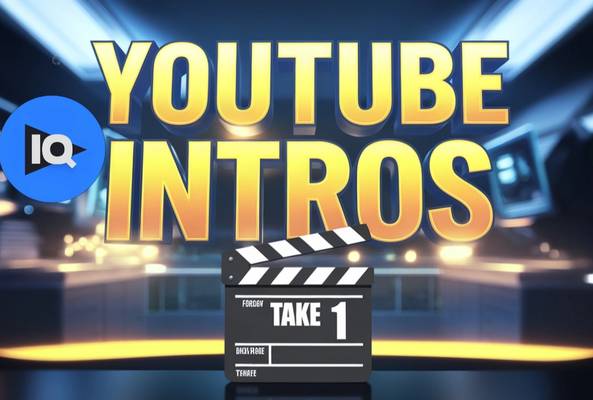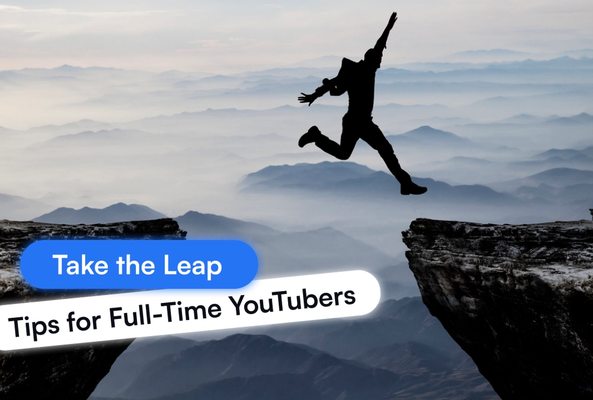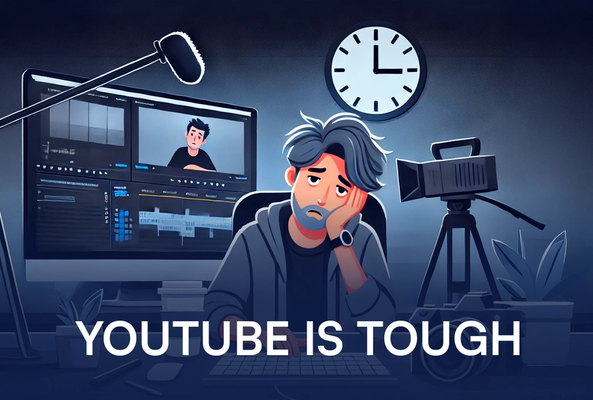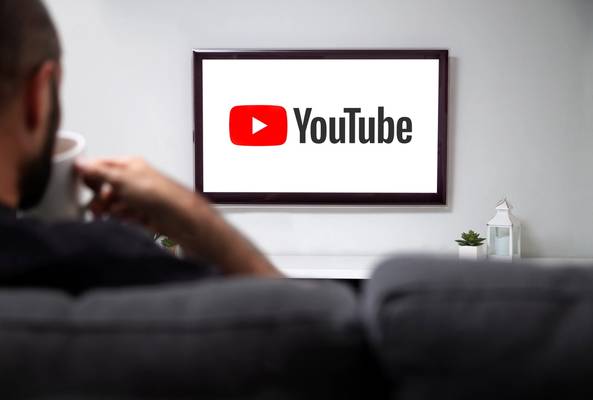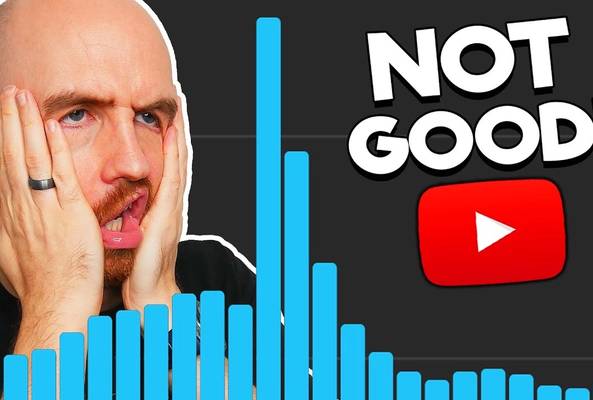Lydia Sweatt is a writer who loves balancing her article/blog time indoors with a healthy dose of nature. She bikes, hikes, and identifies edible plants along the way.
How to Write a YouTube Video Script That Keeps Viewers Watching
For a creator, a good YouTube script is a must. It helps arrange your ideas into a clear story. It also cuts out filler words and stumbles that interrupt your flow. A clear script keeps your message on point.
It also allows you to speak clearly, avoiding common mistakes we all make when speaking. Messing up a word. Saying "um" too many times. Forgetting what you wanted to say altogether.
You can fix this by writing a good video script for YouTube. This guide will show you how to make it engaging, natural, and definitely not cheesy.
But First, What is a YouTube Video Script?
Think of a YouTube script as your video plan. It covers what you will say and what will appear on screen. It helps guide your dialogue and visuals while letting your personality shine.
From a text perspective, your script is also an outline of what you want to say. It's specific enough to read while filming but loose enough to allow for ad-libbing and vocal experimentation.

How to Start Writing an Effective YouTube Script
When writing a script, it's essential to focus on your audience. You're using the document to craft a video they'll enjoy, so the script should speak directly to your viewers.
You need three details to complete this task: who your audience is, the main idea of your video, and the "voice" you want to use.
1. Start with a Video Title or Main Idea
The first step is simple but worth mentioning: You need a video title or idea before sitting down to write. This helps you stay on topic, grab viewers' attention, and provide the information they crave.
Read More: 3 Secrets for Writing Click-Worthy YouTube Titles
Imagine writing a video script about credit cards. Using a title like "How to Squeeze More Value Out of Your Credit Card" is a lot more engaging than "How to Use Your Credit Card Wisely." And as you focus on that winning concept — "squeezing" value instead of "using" a credit card — it's easier to write in that engaging perspective.
You should also add the right keywords to your title (you can easily find the right keywords by using a YouTube keyword research tool). It will help you write an even better script that increases YouTube views, but more on that later.
2. Identify Your Target Audience
It also helps to know who your viewers are before writing a script. This detail is usually related to your YouTube niche. Are you making videos for teen gamers? College students who study abroad? Single dads who seek parenting advice?
With those details in mind, ask yourself what information viewers want or need from the video you're planning. Then try to deliver that value.
This process is called speaking to your target audience. And the best way to do that is by researching their daily challenges, joys, and desires. Then you can craft a video that solves a problem or intensifies their joys.
Most of this research happens on YouTube, so click here to learn the basics of keyword research. You'll learn how often people search for your video's topic, the words they use when searching, and related topics you can use to build out the video.
3. Know Your Channel's Voice
Every YouTube creator has a "voice." Maybe you're the "jester" who cracks jokes and makes people laugh. Or perhaps you're the "adventurer" who takes people on a journey with action-packed scenes.
Whatever your voice is, use it when writing scripts for YouTube videos. It'll help you stand out and attract the right kind of viewers — people who like your personality and hit subscribe.
YouTube Script Template: 4-Part Structure
Now that you know your video's topic, voice, and target audience, you can start outlining a script.
Luckily you don't have to build this from scratch. You can use a well-known YouTube video script format and then personalize it for your content.
Alina Iatiuc, creative producer at vidIQ, writes scripts for the vidIQ channel. Here's the YouTube script template she uses, plus a few tips to make it your own:
- Section 1: Video hook/intro
- Section 2: Main content and research
- Section 3: CTA (call to action)
- Section 4: YouTube end-screen elements
Section 1: Creating a Powerful Video Hook/Intro
The "hook" is the first sentence or two that catches the viewers' attention in a video. It should be one of three things: entertaining, emotional, or informative. If you can do all three, that's even better.
Another thing you want to do is present the main problem you're solving.
For example, we have a YouTube script titled "Trick Anyone into Watching Your Videos." The video hook introduces the problem (no one is watching your videos), promises a solution, entertains viewers, and taps into their emotions:
"Warning! This video will help you learn to hack peoples' minds and trick anyone into watching your videos using science and proven facts."
The hook is brief, engaging, and makes the viewer curious enough to keep watching. Press play below to see what we mean!
But there's more than one way to do this. In fact, here are eight ideas to hook viewers in the first eight seconds.
Section 2: Main Content and Research
This is where you'll write the bulk of your content. For example, you might have 5-10 main points for your video. One by one, you'll give each point a subheader and write the words you want to say for that section.
Don't forget to add information that might be useful, including research and statistics, to support your claims.
"One of the most common mistakes people make when writing a script is not doing enough research and fact-checking," Alina says. "Sharing misleading information will not help build trust with your audience. Moreover, it can destroy a good reputation you've already built."
Section 3: Your CTA (Call to Action)
There should be a clear call to action at the end of every video. Some creators ask for feedback in the form of likes, subscriptions, comments, and shares. Some even encourage people to sign up for their email newsletter. You should write your call to action in a way that drives viewers to your chosen destination.
Section 4: YouTube End Screen Elements
A YouTube end screen is an interactive outro that appears in the last 5-20 seconds of a video. You can place clickable elements on an end screen, such as links to a website, a subscribe button, or extra videos for viewers to watch.

End screens and CTAs go hand-in-hand. You'll use the CTA to bring viewers' attention to the end screen, and you'll use the end screen itself to send viewers where you want them to go.
For example, here's a CTA and end screen paired together:
"If you want to get people to watch more of your content — essentially free videos — then watch this video over here (points to end-screen element showing clickable video)." And by doing that, you're giving me free views!"
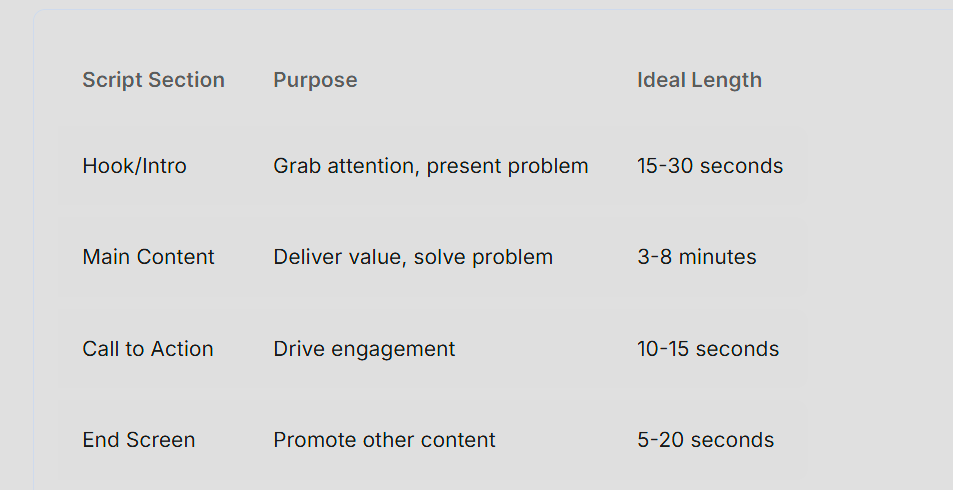
Script Writing Tips to Boost Viewer Engagement
There's planning a video script, and then there's doing the actual writing. Here's how to make sure what you write becomes an entertaining video.
1. Use Short, Punchy Sentences
Long sentences are difficult to read, hear, and understand. That's why you should write shorter sentences for your video script and keep things casual. You'll reduce the information viewers hear so they can follow your train of thought.
At the same time, you don't want every sentence to be brief. Vary the length of your sentences, so they flow like a natural conversation between friends.
2. Use the Present Tense
Writing in the present tense creates a sense of urgency. You'll communicate in the here and now, grabbing viewers' attention to keep them engaged.
3. Write in a Conversational Style
YouTube is pretty laid-back, so use simple words and phrases anyone can understand. You don't want to sound like you're delivering an academic speech or giving a research presentation.
At the same time, don't make your script so informal that it sounds off-putting.
4. Use More Active Voice Than Passive Voice
When you write in the active voice, the subject of a sentence performs an action on something else – a person, idea, or thing. A sentence written in the passive voice doesn't reveal the subject upfront, which gets confusing.
Active voice: Joseph adopted three puppies last winter, and they're growing fast.
Passive voice: Three puppies were adopted by Joseph last winter, and they're growing fast.
The passive sentence requires more effort to understand.
5. Keep it Simple
Remove unnecessary words, sentences, and scenes from your script if they don't add to the story.
6. Sprinkle in Some Humor
Humor adds a cheery, light-hearted tone to your video. Just don't go overboard by cracking offensive jokes that make people feel uncomfortable.
7. Edit Your Script Several Times
Good writing doesn't happen overnight, so read your script and revise it until you're satisfied.
8. Seek Feedback
It's helpful to get feedback before publishing a YouTube video. You can ask friends and family what they think or get serious feedback from a scriptwriter.
Always Prioritize Your Audience
The beauty of scriptwriting is that you don't need to be an expert. Anyone can sit down and create a vision for their YouTube video, from the storyline to the spoken words to the special effects sprinkled on top.

But to create outstanding scripts, you do need to be an expert in one thing: prioritizing your viewers and no one else.
"A YouTube video script is engaging when a content creator understands their audience and writes for the people and not for the ego," Alina says. "Before starting to write a script, I ask myself: "What is the problem I want to help my audience solve? How can I solve it so that people find the solution helpful?"
Script Templates for Different Video Types
YouTube videos come in many styles. For tutorials, list clear steps with timestamps. Start by stating the problem and then show each step so your viewers know what comes next.
- For vlogs, use a loose outline. Write down scene ideas and key points. This way, your style stays natural while you cover all the topics.
- When making educational videos, set up your script like a short lesson. Introduce the topic, share your main points with examples or demos, and finish with a quick recap. Mark important times to make editing easier.
- For commentary videos, keep your viewpoint clear. Begin with your main idea, share facts or examples, mention other viewpoints, and wrap up with your final thoughts.
- When reviewing products, stick to a set format. Introduce the item, talk about your experience, list the good and bad points, compare it to other options, and give your final recommendation.
Now that you've learned how to write scripts that make viewers stick, how about YouTube video descriptions next?
FAQs
How long should a YouTube script be?
Match your script's word count to your video length. For a 5-minute video, try 750-900 words.
How to script a YouTube video?
Try a two-column format: one side for spoken content and the other for visual notes. Include timestamps, section headers, and highlight key points to guide filming. AI can help with ideas or a rough outline. Just be sure to add your own voice to make the script engaging.
What's the most important part of a YouTube script?
The hook is most important. The first 15 seconds decide if viewers stay. Use it to show a problem, promise a fix, or spark curiosity.
How do I make my YouTube script sound natural?
Write like you talk. Read your script aloud during edits. Use short sentences and everyday words so it sounds real.
Do I need to write every word in my YouTube script?
No. Your script should guide you without being too strict. Many creators use bullet points when they want to speak more freely.

